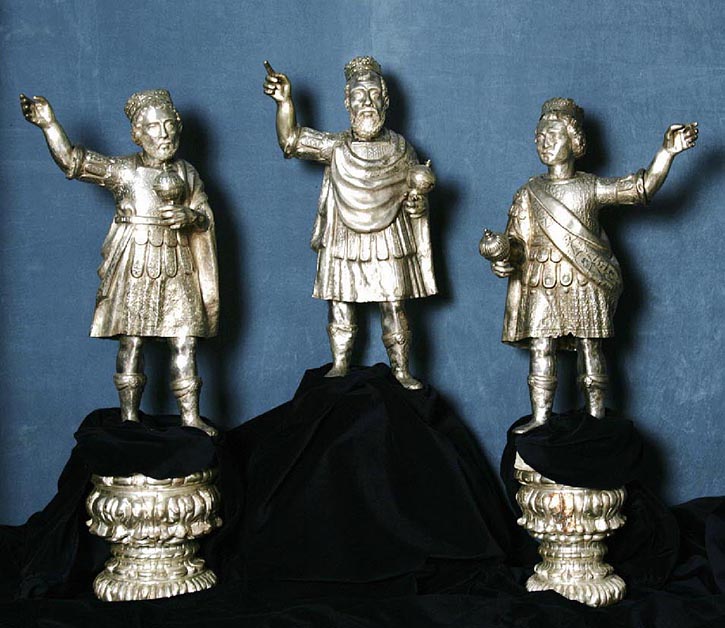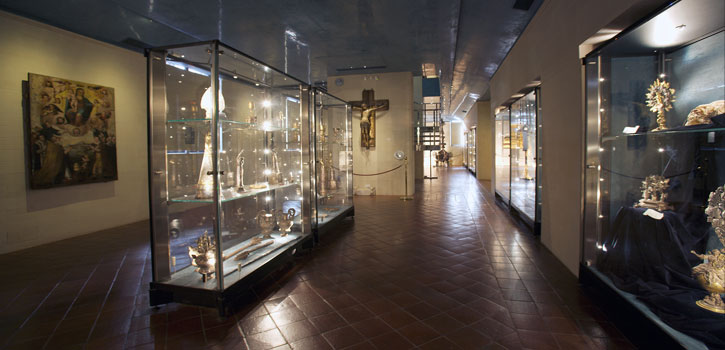
The ground floor exhibits some of the most representative works of the museum, among which, in the first room, there are:
A rock crystal lamp called Pigna, which means pine cone, because of its shape. It can be dated between 969 and 1250.
It is the most ancient work of the collection and it is classified as a crystal of the Fatimid era. It is made of a single block of rock crystal, sculpted with large notches in relief. We don’t know the original use of this work, probably a jar or an ornamental vase, or a lamp for the Chapel of the Holy Sacrament.
As reported in various historical chronicles, in the 17th century it was used as a reliquary to carry the Sacred Hair of the Madonna in procession. After the 1943 bombings it was seriously damaged and substituted by a glass copy for the procession.
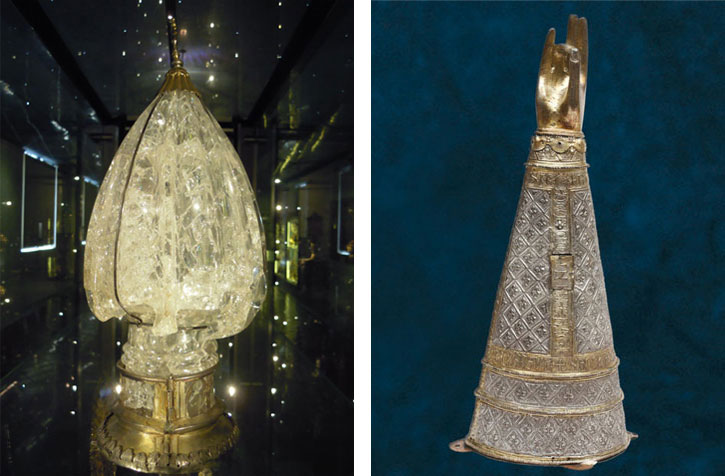
The Reliquary arm of Saint Marciano, first martyr and bishop of Syracuse has a conical shape and is made of silver, partially gilded. It is embossed and engraved with rhombi and lilies, the latter being the symbol of purity and virginity of Saints. A hand, blessing in the Greek manner, protrudes from the lace trimmed sleeve. The three fingers symbolize the Holy trinity, while the two joined ones are the symbol of the human and divine nature of Jesus Crhist. An inscription in uncial letters says that the reliquary contains a fragment of bone from St. Marcian’s arm and was commissioned by Richard Palmer, Bishop of Syracuse. The reliquary was brought to Messina by Palmer when he became Archbishop of the city in February 1182.
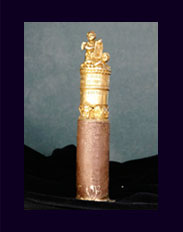
Another work related to the devotion to the Madonna of the Letter is the reliquary of the Sacred Hair of the Madonna, which is still carried in procession on 3rd June, the Saint’s feast day.
It has a cylindrical engraved silver base on which an angel in gilded silver is holding a small scroll, which bears the inscription “MARIA VIRGO MESSANENSIBUS OMNIBUS SALUTEM”.
An inscription in gothic letters on the stem indicates the relic kept inside. Work of Pietro Juvarra. C.17.
A processional cross, in silver leaf embossed and worked on a wooden core. The cross portrays the crucified Christ with the Virgin Mary on His left, the Archangel Michael above Him and St. John the Evangelist on His right. At the feet of Jesus is Mount Golgotha, also called “the place of the skull”.
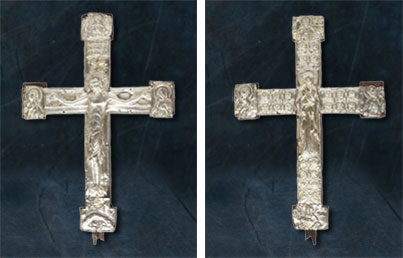 A Greek inscription above Christ’s head reads: Jesus Christ / King of Glory. There are several circular depressions on the back of the cross, possibly once used to hold gemstones or relics, which are no longer present. On the reverse side is a praying Madonna, in Byzantine icon style, and the four Evangelists on either side; the background is decorated with plant tracery, also showing a Byzantine influence. C.12-13.
A Greek inscription above Christ’s head reads: Jesus Christ / King of Glory. There are several circular depressions on the back of the cross, possibly once used to hold gemstones or relics, which are no longer present. On the reverse side is a praying Madonna, in Byzantine icon style, and the four Evangelists on either side; the background is decorated with plant tracery, also showing a Byzantine influence. C.12-13.
A gilded silver chalice decorated with 36 translucent enamels. The chalice, as referred by an inscription on the knot, was commissioned by Soru Stefania Rufula, a nun belonging to the order of St. Clare, probably around 1348. It was created by Giovanni di Ser Jacopo from Florence, in Naples. At the time he was the royal goldsmith of the Queen Joanna I of Naples. There are many references to the Franciscan spirituality such us the enamelled figures of Saint Francis of Assisi and Saint Clare in the knot. The enamel on the base represent: Our Lady of Sorrows, Christ Crucified, Saint John the Evangelist, Saint Peter, Saint Paul and Saint John the Baptist. In different parts of the chalice some symbolic water birds are depicted and among them the pelican, symbol of Christ.
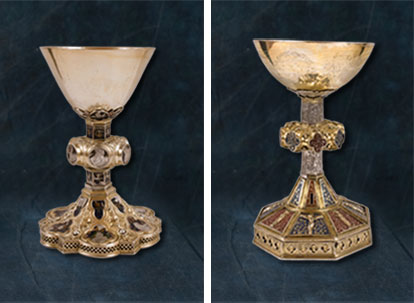 A gilded silver chalice, donated by Filippo Crispo, Archbishop of Messina from 1392 to 1402. The chalice has an octagonal base and presents a decoration with red and blue enamel. They present leafy branches and relief figures of several Saints and Christ on the Cross. In the stem of the chalice some nails, symbols of the Passion of Christ, and the coat of arms of the prelate are engraved. C.14-15.
A gilded silver chalice, donated by Filippo Crispo, Archbishop of Messina from 1392 to 1402. The chalice has an octagonal base and presents a decoration with red and blue enamel. They present leafy branches and relief figures of several Saints and Christ on the Cross. In the stem of the chalice some nails, symbols of the Passion of Christ, and the coat of arms of the prelate are engraved. C.14-15.
A golden monstrance with a complex architectural structure. It has an octagonal base, decorated with five circular enamel depicting episodes from the Old and New Testaments: the Last Supper, the Supper at Emmaus, David taking the Holy Ark to Jerusalem, Elijah with the angel and Isaac ready for sacrifice. The only scene made of melted and embossed gold represents Melchisedek offering bread and wine to Abraham.
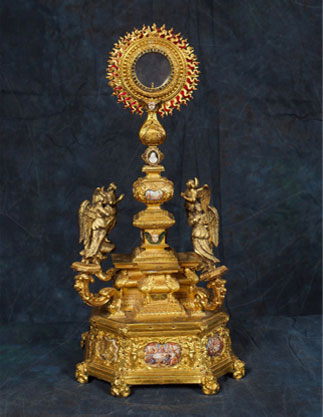
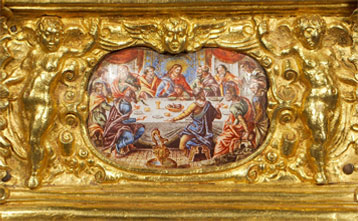 Four arms rise from the corners of the base. Four gilded bronze angels stand on them, facing towards the centre in order to pray and worship the Holy Sacrament.
Four arms rise from the corners of the base. Four gilded bronze angels stand on them, facing towards the centre in order to pray and worship the Holy Sacrament.
The monstrance’s stem is particularly complex: the central element rises on four lion paws; it is decorated with gold and enamelled winged heads. Above it is an oval knot with four more Biblical scenes in enamel: Joseph and his brothers in Egypt, Moses striking water from the stone, Moses lifting up the serpent in the wilderness and Samson drinking from the ass’s jaw after killing the Philistines. Above this knot, a ring with a cameo represents the Sacred Heart of Jesus, framed with diamonds. The radiant crown is decorated with red enamel. The receptacle is adorned with a frame of diamonds. The monstrance was probably made by Giuseppe Bruno, messinese goldsmith specialised for enamelled works, C.17.
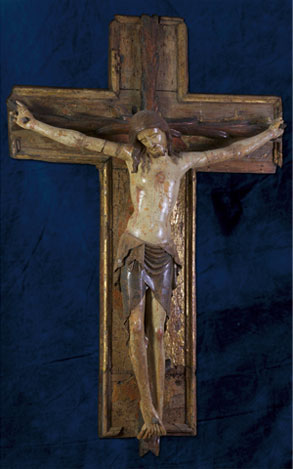
A wood and plaster crucifix, from the private chapel of the D’Alcontres family. It was taken there on being discovered in a ruined church after the 1908 earthquake.
It shows a slender figure of Christ with His arms outstretched, His head leaning slightly to the right with an expression of pain on His face, His eyes closed and His mouth slightly open, as if He were drawing His last breath.
The Cross is worked in a double layer of wood, and the upper layer has branches symbolising the Tree of Life. The crucifix is attributed to the Pilli workshop of Messina and can be dated between the end of 15th century and the beginning of the 16th century.
The three statues represent the Magi; they are made in an embossed and engraved silver lamina.
They were made in 1640 and are very accurate in the expressions of the faces and the details of the robes. The statues used to be carried through the city streets by the Military Order of the Star in the Epiphany procession.
Historical sources narrate that the procession “… consisted of 100 of the city’s leading noblemen, in their gala robes and with the gold star on their breast,(…) all carrying burning torches, and, behind, under an ornate canopy carried by Senators in their togas, on a richly and nobly decorated silver stand, were the three statues of the Magi and, above them, the Star with the Crystal Vase in which the Hair of the Virgin Mary was lying (…)”.
